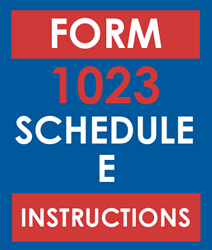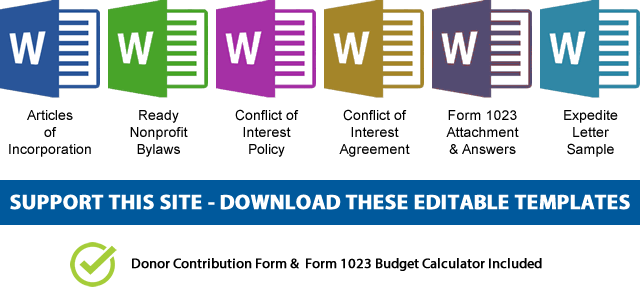Instructions on how to answer the questions on the Form 1023 Schedule E
 Schedule E of the Form 1023 is for organizations that are applying for tax exemption after 27 months has passed since their incorporation.
Schedule E of the Form 1023 is for organizations that are applying for tax exemption after 27 months has passed since their incorporation.
Under normal circumstances, nonprofit organizations have 27 months to apply for tax exemption and their revenue will be exempt from the date of their incorporation.
The Schedule E also addresses reinstatement of tax exemption status time line.
The questions in this schedule will help the IRS determine the effective date of exemption if you’re either seeking reinstatement after automatic revocation or you’re filing this application more than 27 months after the end of the month in which you were legally formed.
Form 1023 Schedule E Line 1.
Answer “Yes,” if your exempt status was automatically revoked under section 6033(j)(1) for failure to file required annual returns or notices for 3 consecutive years and you’re applying for reinstatement.
Rev. Proc. 2014-11, 2014-3 I.R.B. 411, at IRS.gov/irb/2014-03_IRB establishes several different procedures for reinstating an organization’s exempt status depending upon its size, the number of times it’s been automatically revoked, and the timeliness of filing for reinstatement. Review the revenue procedure to determine which section applies to you.
Form 1023 Schedule E Line 1a.
Select the section of Rev. Proc. 2014-11 under which you’re applying for reinstatement.
Form 1023 Schedule E Section 4.
Select this section if:
- You were eligible to file either Form 990-EZ or Form 990-N for each of the 3 consecutive years that you failed to file;
- This is the first time you’ve been automatically revoked pursuant to section 6033(j)(1); and
- You’re submitting this application no later than 15 months after the later of the date of your Revocation Letter or the date on which the IRS posted your name on the Auto-Revocation List at irs.gov/app/eos/.
By selecting this item, you’re also attesting that your failure to file wasn’t intentional and you’ve put in place procedures to file required returns or notices in the future.
If you were classified as a private foundation prior to your automatic revocation, you weren’t eligible to file either Form 990-EZ or Form 990-N and, therefore, aren’t eligible to request reinstatement under Section 4.
If your exempt status was automatically revoked more than once, you’re not eligible for reinstatement under Section 4; however, you may apply for reinstatement under Section 5, Section 6, or Section 7.
Form 1023 Schedule E Section 5.
Select this section if:
- You’re ineligible to file for reinstatement under Section 4, and
- You’re submitting this application not later than 15 months after the later of the date of your Revocation Letter or the date on which the IRS posted your name on the Auto-Revocation List.
By selecting this item, you’re also attesting that you filed the required annual returns, your failure to file was not intentional, and you have put in place procedures to file required returns or notices in the future.
Describe how you exercised ordinary business care and prudence in determining and attempting to comply with your filing requirements in at least 1 of the 3 years of revocation. Include a detailed explanation of all the facts and circumstances that led to the failure, the discovery of the failure, and the steps you have taken or will take to avoid or to mitigate future failures to file timely returns or notices.
Form 1023 Schedule E Section 6.
Select this section if you are applying for reinstatement of your tax-exempt status more than 15 months from the later of the date of the Revocation Letter or the date on which the IRS posted your name on the Auto-Revocation List.
By selecting this item, you’re also attesting that you filed the required annual returns, your failure to file wasn’t intentional, and you have put in place procedures to file required returns or notices in the future.
Describe how you exercised ordinary business care and prudence in determining and attempting to comply with your filing requirements in each of the 3 years of revocation. Include a detailed explanation of all the facts and circumstances that led to the failure, the discovery of the failure, and the steps you have taken or will take to avoid or mitigate future failures to file timely returns or notices.
Form 1023 Schedule E Section 7.
Select this section if you’re seeking reinstatement with an effective date of reinstatement of the date of submission of this application.
Form 1023 Schedule E Line 2.
Generally, if you didn’t file Form 1023 within 27 months of formation, the effective date of your exempt status will be the date you filed Form 1023 (submission date). IRS may grant requests for an earlier effective date when there’s evidence to establish you acted reasonably and in good faith, and the grant of relief won’t prejudice the interests of the government.
Select the appropriate box to indicate whether you accept the submission date as the effective date of your exempt status or whether you are requesting an earlier effective date.
Form 1023 Schedule E Line 2a.
You may be eligible for consideration for relief from the requirement that you file Form 1023 within 27 months of formation if you can establish that you acted reasonably and in good faith, and that granting an extension won’t prejudice the interests of the government.
Describe in detail your reasons for filing late, how you discovered your failure to file, any reliance on professional advice or advice from the IRS, and any other information you believe will support your request for relief. Also, you may want to provide a comparison of (1) what your aggregate tax liability would be if you had filed this application within the 27-month period with (2) what your aggregate liability would be if you were exempt as of your formation date.
IRS may consider the following factors.
- You filed Form 1023 before IRS discovered your failure to file.
- You failed to file because of intervening events beyond your control.
- You exercised reasonable diligence, but you weren’t aware of the filing requirements. (The complexity of your filing and experience in these matters may be taken into consideration.)
- You reasonably relied on written advice from us.
- You reasonably relied on the advice of a qualified tax professional who failed to file or advise you to file Form 1023.
 NOTE: If you’d like to receive the following organizing documents:
NOTE: If you’d like to receive the following organizing documents:- Nonprofit Articles of Incorporation,
- Nonprofit Bylaws,
- Nonprofit Conflict of Interest Policy,
- Conflict of Interest Policy Acknowledgment,
- Form 1023 Attachment with all the answers,
- Form 1023 Expedite Letter template,
- and Donor Contribution Form
in Microsoft Word Document format, please consider making a donation and you’ll get to download them immediately. Not only they're worth well over $1000 in value, they will save you weeks of copy pasting and formatting as they are ready to go templates which only need changing names and addresses.

